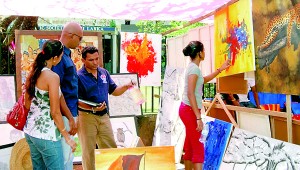‘Kala Pola’, the living cultural legacy of George Keyt
View(s):By Nihal Rodrigo
This year’s ‘Kala Pola’ (Art Fair), organised by the George Keyt Foundation in collaboration with the John Keells Group will be held on Saturday, January 26 from 8 a.m. to 10 p.m. and on Sunday 27 from 8 a.m. to 6 p.m. at the Nelum Pokuna Mawatha (formerly Ananda Coomaraswamy Mawatha) near the Colombo Art Gallery.
This annual public event honours the living cultural legacy of painter, poet and writer George Keyt (1901-1993). For the John Keells Group, this is much more than the fulfilment of Corporate Social Responsibility (CSR): it needs to be described as an exemplary contribution to ‘Corporate Cultural Cooperation’ as well. 
The cultural legacy of George Keyt endures. He had his education at Trinity College, Kandy and was employed for a while as a photographer at the Phoenix Studio in Kandy. He later spent some years at the Malwatte Temple, nearly a century ago, when the Ven. Pinnawella Dhirananda was the Mahanayake Thera. Though born a Burgher Christian, Keyt immersed himself in Buddhist philosophy and even contemplated entering the Buddhist clergy.
The magnificent murals depicting the life of the Lord Buddha at the Gotami Vihare in Borella are among his enduring contributions to Buddhist culture. In 1983, the Sri Lanka Postal Department, when issuing Vesak commemorative postage stamps, featured some of these murals. His knowledge of Hindu philosophy, art and culture was also extensive, and is reflected in the themes of many of his paintings, as well as his poetry and writings, including the translation of Jayadeva’s Sanskrit classic, the Gita Govinda.
His manifold achievements need to be placed in the larger context of South Asia’s rich and varied cultural heritage. William G. Archer of the British Museum, in his pioneering 1959 book, ‘India and Modern Art’, placed him then, together with the Indian painters, Rabindranath Tagore, Amrit Sher-Gil and Jamini Roy, as the four greatest modern artists of the South Asian sub-continental cultural matrix.
The first ‘Kala Pola’ in 1993, which Keyt personally attended, attracted a modest number of around 30 Sri Lankan artists. For ‘Kala Pola 2013’, well over 300 artists have registered as participants and will be exhibiting their works on Nelum Pokuna Mawatha.
The contribution that Kala Pola makes to the careers of emerging painters and sculptors from all parts of Sri Lanka is growing each year. A major legacy of Keyt is therefore the opportunity his talents and creativity have come to afford young artists. This includes, in particular the opportunity provided to them to present their work to the increasingly large and diverse public that annually visits the Kala Pola. Talent is being recognised in the responses that are evoked by the thousands strolling along the Nelum Pokuna Mawatha during the ‘Kala Pola’ to view the work of the large number of participating painters and sculptors.
Many artists, including those from rural environments, have derived much more than what they may collect from merely the sale of their work. At last year’s ‘Kala Pola’, artists had earned around a total of Rs. 7 million.
Follow @timesonlinelk
comments powered by Disqus




















